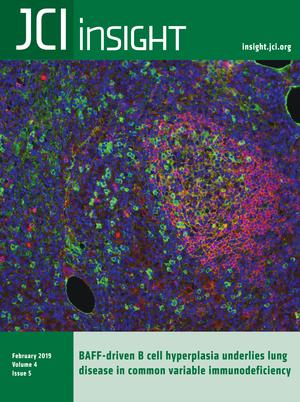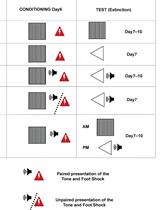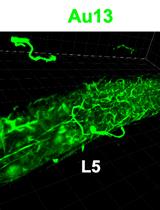- EN - English
- CN - 中文
An Operant Conditioning Task to Assess the Choice between Wheel Running and Palatable Food in Mice
一项小鼠在转轮装置和可口食物之间选择的操作式条件反射测试
发布: 2019年10月05日第9卷第19期 DOI: 10.21769/BioProtoc.3381 浏览次数: 4393
评审: Arnau Busquets-GarciaElena Martin GarciaMarco Venniro

相关实验方案
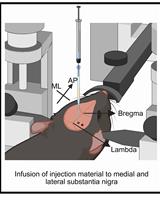
基于 rAAV-α-Syn 与 α-Syn 预成纤维共同构建的帕金森病一体化小鼠模型
Santhosh Kumar Subramanya [...] Poonam Thakur
2025年12月05日 1391 阅读
Abstract
Wheel running, especially in the homecage, has been widely used to study the neurobiology of exercise because animal tends to use it voluntarily. However, as for each reward, its consumption (in the present case, running performance) does not specifically provide information on its incentive value, i.e., the extent to which animals are motivated to run independently from their consumption of that reward. This is a major drawback, especially when focusing on the neurobiology governing the pathological imbalances between exercise and e.g., feeding (obesity, anorexia nervosa). Yet, few studies have shown that operant conditioning wherein wheel-running is used as a reinforcer that can be "consumed" after nose-poking or lever-pressing allows to distinguish motivation from consumption. Thus, nose-poking or lever-pressing under a progressive ratio schedule of reinforcement in animals trained under fixed ratio reinforcement schedules provides, through the so-called breakpoint, an index of running motivation. As compared to wheel-running, numerous studies have used food as a reinforcer, which helped to uncover the neurobiology of feeding. However, to our knowledge, there is no paradigm allowing the assessment of the choice between running and feeding when presented in concurrence, with the possibility to measure a priori the motivation for each reward. Herein, we describe a protocol that first permits to measure the drive for each of these two rewards before it allows to measure the preference for one over the other in a reward choice setting. This paradigm could help to better characterize the neurobiology underlying pathological imbalances between physical activity and feeding, which is the core feature of eating disorders.
Keywords: Operant conditioning (操作式条件反射)Background
Physical inactivity is a growing burden for society nowadays, and it finds its root in a lack of motivation to engage in or to adhere to a long-term exercise program (Ekkekakis et al., 2008). More broadly, eating disorders result from an alteration of the energy balance, between caloric intake (e.g., food intake) and expenses (e.g., physical activity). Interestingly, such an alteration finds its origin at the motivation level. It is thus of prime importance to study in a combined manner the motivation for physical activity with the motivation for food intake. To unravel the neurobiology behind exercise motivation, most studies have used the running wheel paradigm as wheel-running is a volitional and well-conserved behavior with highly rewarding properties (Sherwin, 1998). Indeed wheel running is able to reinforce operant conditioning (Belke, 1997), even when the duration of running is minimal (Iversen, 1993). The basic principle of operant conditioning is to render the reward access contingent to the realization of an effort (e.g., lever pressing, nose-poking). By progressively increasing the effort, it allows estimating the animal’s motivation for this reward. However, studying motivation for physical activity in the context of eating disorders requires to compare it with the motivation for food intake in order to integrate both aspects of energy balance. Noteworthy is the observation that the comparison between the maximal efforts the animal displays for each reward taken individually can be misleading because it doesn’t represent the preference for one reward over another in the natural context of a choice between these rewards (Cantin et al., 2010, in this paper the authors designed an operant conditioning protocol to assess the choice between cocaine and sucrose). A previous study investigated the choice between wheel-running and sucrose in a T-maze (Correa et al., 2016). Although providing a cue with regard to the preference between the rewards under effort-less conditions, this approach does not allow to dissect the motivation for each reward from its mere consumption. To our knowledge, the protocol we are describing here is the first to allow the a priori assessment of motivation for both wheel running and palatable food, and the preference for one over the other in a concurrent choice context using operant conditioning (Muguruza et al., 2019). Such a protocol allows access to both sides of the energy balance as to study the mechanisms involved in such a regulation. Furthermore, by modulating the effort that is required for each reward, one can externally affect the preference for one reward over the other one, hence helping to assess the neurobiological grounds governing each preference level. As it is the case for most studies investigating reward neurobiology, our protocol bears some limitations. Even though animals are always exposed to the operant chambers during their active phase (dark phase), this daily single and restricted exposure cannot fully recapitulate the human situation. Indeed, the animals are exposed to this concurrent choice once a day in a different environment than their homecage when humans have permanently to choose between concurrent rewarding activities. One possibility to circumvent this limitation would be to host the animal in an operant chamber where it would access running and feeding activities, these being fully contingent to an effort (namely nose poking).
Materials and Reagents
- C57Bl/6N mouse line (Janvier Labs): used to validate the protocol (7-8 weeks old)
Notes:- The use of other mouse lines is possible in the following protocol given that no learning or motor deficits are observed in this line. Hereafter we show example of graphs based on the use of a transgenic line, the SimCB1 mouse line (C57Bl/6N background).
- The size and the strength of the mouse are important to take into account so as to screw the wheel properly, avoiding a spontaneous rotation (too loose) or the impossibility for the animal to make it turn (too tight).
- Safe A03 (Safe Diet, U8200G10R, stored at room temperature after opening) contains 3.4 Kcal/g (61.3 percent from carbohydrates, 25.2 percent from proteins and 13.5 percent from fat): Standard homecage food
- Dustless Precision Pellets®, 20 mg, Rodent Purified Diet, Chocolate Flavor (BioServ, Product #F05301, stored at room temperature with silica gel after opening) contains 3.60 Kcal/g (65.6 percent from carbohydrates, 20.6 percent from proteins and 13.9 percent from fat) with an addition of a chocolate flavoring : Palatable food reward
- Phagospray® (Laboratoire Phagogène, Christeyns France). Antimicrobial disinfectant spray designed for non-invasive medical devices and surfaces: used to clean the operant chambers between animals
Equipment
- Apparatus: Operant conditioning chamber (Imetronic, 156 avenue Jean Jaurès 33600 Pessac, France, customized apparatus) (Figure 1)
Individual operant conditioning chamber (28 cm long x 26 cm wide x 38 cm high) placed in a wooden case (60 cm long x 62 cm wide x 49 cm high) ventilated to ensure air circulation and background noise. The rear side has a 20 cm diameter wheel mounted at the center, surrounded by two nose poke ports, with a brake pad on top of it to be able to lock or unlock it. The left panel has a food tray placed at the center surrounded by two nose poke ports. Both panels (rear or left) can be hidden using grey Perspex depending on the task. The floor consists of a grid above a drawer filled with litter (same litter as animals’ homecages). All operant chambers are connected to a computer through an interface allowing (i) the allocation of files and exercise (see following sections) for each animal/cage and (ii) real-time visualization of animal behavior and recordings. For a given batch of animal, the active nose poke port is allocated to be the right one for half of the animals, and the left for the other half in order to counterbalance the position.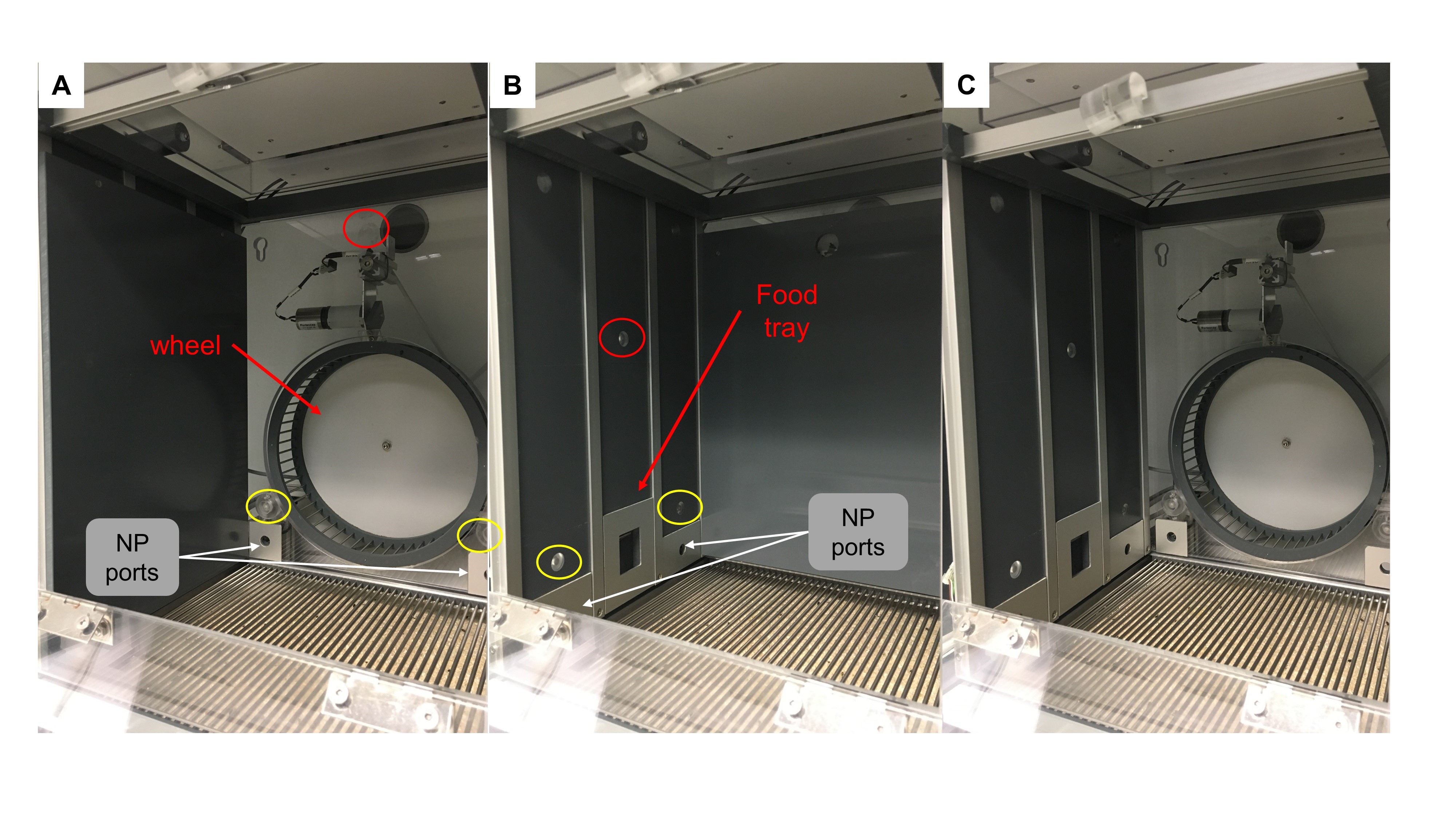
Figure 1. Operant chambers for wheel running and palatable food. A. The configuration for wheel running involves a wheel mounted on the rear side surrounded by two nose poke ports associated with light cues (yellow circles) that can be paired with another light cue (red circle) on the top of the wheel (the left panel being covered by gray Perspex). The floor is constituted of a metal grid on the top of a litter drawer. B. The configuration for palatable food involves a food tray on the left panel surrounded by two nose poke ports associated with light cues (yellow circle) that can be paired with another light cue (red circle) on the top of the food tray (the rear side covered by gray Perspex). The floor is made of a metal grid on the top of a litter drawer. C. The choice configuration involves the removal of the two gray Perspex sides to free the access to both rewards. The floor is made of a metal grid on the top of a litter drawer. Illustration taken from Hurel et al. (2019).
Software
- Polywheel 5.2.2 (16/04/2015) Imetronic, 156 avenue Jean Jaurès 33600 Pessac, France: Software used on-line allowing the allocation of exercise (see section “procedure” and sub-sections “exercise design”), and the real-time acquisition of data from the operant chambers
- Poly files V4.5.2 (09/04/2018) Imetronic, 156 avenue Jean Jaurès 33600 Pessac, France: Software used off-line to extract data using pre-defined variables into Excel files
- GraphPad Prism version 8 (GraphPad Software 2365 Northside Dr., suite 560, San Diego, CA 92108): Data analysis
Procedure
文章信息
版权信息
© 2019 The Authors; exclusive licensee Bio-protocol LLC.
如何引用
Redon, B., Hurel, I., Marsicano, G. and Chaouloff, F. (2019). An Operant Conditioning Task to Assess the Choice between Wheel Running and Palatable Food in Mice. Bio-protocol 9(19): e3381. DOI: 10.21769/BioProtoc.3381.
分类
神经科学 > 神经系统疾病 > 动物模型
神经科学 > 神经系统疾病 > 动物模型
您对这篇实验方法有问题吗?
在此处发布您的问题,我们将邀请本文作者来回答。同时,我们会将您的问题发布到Bio-protocol Exchange,以便寻求社区成员的帮助。
Share
Bluesky
X
Copy link



